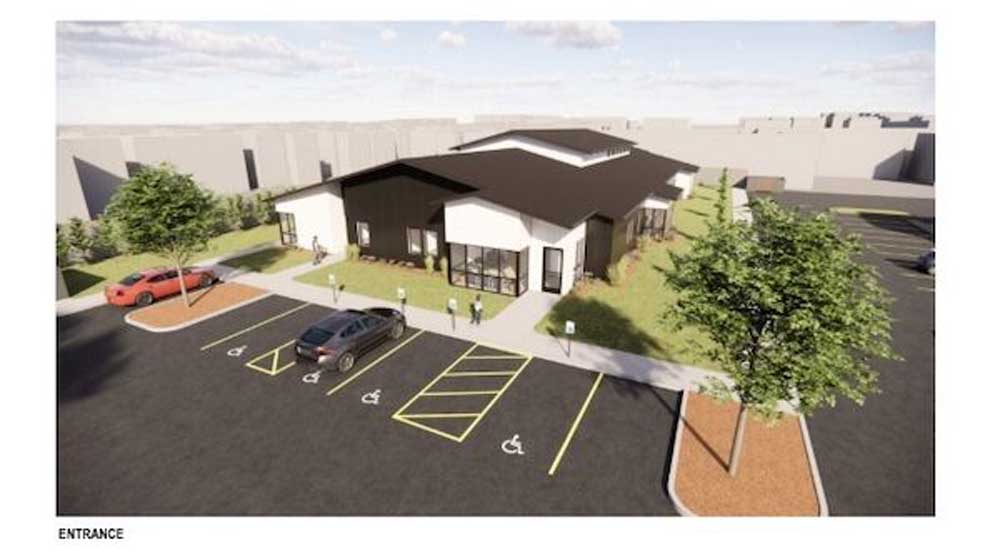Plans greenlit for Addictions Recovery Center detox facility
Published 10:45 am Tuesday, June 11, 2024

- As showed in this rendering, Addictions Recovery Center's planned 10,500-square-foot expansion at 1025 E. Main St. in Medford would house its "Fresh Start Withdrawal Management" inpatient detox program.
Medford’s Site Plan and Architectural Commission has approved plans for a 10,500-square-foot withdrawal treatment facility on East Main Street, but only after scrutiny, a short discussion of what the commission can enforce and the Addictions Recovery Center CEO agreeing to limits on how the facility will be operated.
The expansion on property that Addictions Recovery Center already owns at 1025 E. Main St. includes accommodations to effectively double its “Fresh Start Withdrawal Management” services from 10 to 20 patients. According to plans in the Medford meeting packet and a presentation made June 7 at city hall by architect David Wilkerson of ORW Architecture, the facility’s blueprints include 18 patient rooms, two medical step-down rooms and multiple consultation, therapy, provider and medical rooms.
“The objective of the facility is to provide a safe and secure place for folks to stay while they are detoxing,” Wilkerson said. He added that the facility also provides patients space to meet with case managers, counselors and treatment providers.
Commissioner Rick Whitlock pressed Wilkerson and Addictions Recovery Center President and CEO Eric Guyer on questions of security and safety.
“When you say the building is secure, what does that mean?” Whitlock asked.
“It is not a lockdown facility — the residents could leave if they wanted to,” Wilkerson said. “It’s secure just in terms of providing a safe place for them to begin their recovery.”
Wilkerson added that the space offers the detoxing patient a private room, a private bathroom and meals. “It’s that sort of safety and security that we’re talking about.”
Whitlock asked whether there are typically “episodes of violence” at withdrawal treatment facilities. Guyer said, “No. Not typically with these facilities.”
“These types of facilities usually are addressing folks with a much lower state of energy … and they tend to be more subdued in that sense,” Guyer said. “And it’s also secured in the sense of outdoor visitors, guests are really limited.”
Family and friends don’t typically visit, and open admissions are not taken at the facility.
“It’s pretty planned in terms of how people are admitted to the program,” Guyer said.
Addictions Recovery Center currently provides withdrawal management services on the back half of its sobering center facility on Front Street in downtown Medford, Guyer told commissioners. It typically treats people withdrawing from narcotics such as opiates and methamphetamine, as well as people withdrawing from alcohol.
Whitlock asked whether there have been security incidents at the Front Street location where police needed to be called.
“Yes, and it’s been mostly — I would say 98% of the time — for the people who are in our sobering units,” Guyer said. “It’s been a tough compatibility measure in terms of how we’re currently located; however, we do have 24/7 staffing requirements in both of those facilities.”
As a Level 3.7 treatment center, the facility will provide roughly double the capacity of the Medically Monitored High-Intensity inpatient services it already offers. Patients stay at the facility about five to seven days before moving on to the next step of their treatment.
The program is a medically monitored withdrawal management program intended to provide a “physically and emotionally stable environment while a patient completes the detox process and prepares for transition to another level of treatment services,” according to the program’s website. Licensed medical professionals such as family nurse practitioners, registered nurses and licensed practical nurses are available to the detox patients 24 hours a day.
Concerns
Two residents who live nearby voiced concerns. A woman brought up that Roosevelt Elementary School is located 600 feet from the facility. She said she was concerned about violence, describing how the detox facility puts people “getting off drugs” who are “not in their right mind” near the school.
“I feel bad for the people, but I’m also concerned about my neighborhood,” the woman said.
“We definitely acknowledge and respect and want to protect the access to Reddy Avenue and Roosevelt School and Hedrick junior high, which is over and across the street from that property,” Guyer said in response.
Guyer told commissioners that the facility is locked from the outside, so it won’t have much incoming and outgoing traffic. The facility releases and removes people from the facility during daytime hours.
“Folks are actually stabilized through this process so we believe we’ll have limited effects on the neighborhood and don’t anticipate any effects on the schools,” Guyer said.
Whitlock recognized the neighbors concerns before highlighting that security is a greater concern at the sobering center, not the detox and withdrawal facility on the table.
“I recognize the concerns of the neighbor, but I do believe that ARC will be a great neighbor,” Whitlock said.
The motion
Commissioner Jeff Thomas suggested adding language in the proposal that would prohibit a sobering center down the line. Assistant Planning Director Kelly Akin told the board she wasn’t confident they had the authority to “prohibit uses that are permitted within the zone.”
“I’m not confident that you have the ability to prohibit permitted uses,” Akin said.
Guyer said during reopened public comments that Addictions Recovery Center had “no problems” with restrictions as brought up, although he voiced concern the language involved is “under-defined” in statute.
“We just want to make sure we can comply with any stipulations that are in there regarding this,” Guyer said.
With Guyer’s agreement, Addictions Recovery Center would agree to stick with the uses as presented in their application. Whitlock made the motion that included the stipulation, and Bob Neathamer seconded. The motion passed 6-0. Vice Chair Jeffrey Bender abstained because he is a partner of ORW Architecture, and Commissioner Elle Powell was not present.
During the hearing, another neighbor voiced concerns of “what is the plan” if the facility later negatively impacts the neighborhood.
“I was hoping there would be some plan in place if things get out of hand,” the man said.
Senior Assistant City Attorney Garrett Ramsey noted that the city has avenues in its municipal code for declaring public nuisance properties if there are repeated, ongoing law violations associated with the facility.
“There are remedies that the city of Medford and residents have,” Ramsey said.






